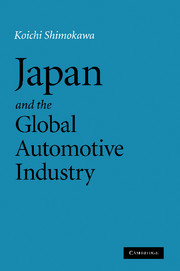Book contents
- Frontmatter
- Contents
- List of figures
- List of tables
- Preface
- Introduction
- 1 Comparing productivity of the Japanese and US automobile industries
- 2 The internationalization of the Japanese automotive industry and local production overseas
- 3 The recovery of European and US auto makers, and relocating and changing lean production
- 4 Early 1990s – the Japanese automotive industry loses international competitiveness, and the development of restructuring strategies
- 5 The restructuring of the global automotive and auto-parts industries
- 6 The restructuring of the world's auto-parts industry and the transfiguration of the keiretsu parts transaction
- 7 Global M&A and the future of the global auto industry – the light and dark sides of merger and re-alignment
- 8 The Asian and ASEAN automotive industries in the global era
- 9 China's automotive industry in the global era, Japanese auto makers, and their China strategies
- 10 Conclusion – the global automotive industry's perspective on the twenty-first century and tasks for the Japanese automotive industry
- Epilogue
- Index
- References
6 - The restructuring of the world's auto-parts industry and the transfiguration of the keiretsu parts transaction
Published online by Cambridge University Press: 06 July 2010
- Frontmatter
- Contents
- List of figures
- List of tables
- Preface
- Introduction
- 1 Comparing productivity of the Japanese and US automobile industries
- 2 The internationalization of the Japanese automotive industry and local production overseas
- 3 The recovery of European and US auto makers, and relocating and changing lean production
- 4 Early 1990s – the Japanese automotive industry loses international competitiveness, and the development of restructuring strategies
- 5 The restructuring of the global automotive and auto-parts industries
- 6 The restructuring of the world's auto-parts industry and the transfiguration of the keiretsu parts transaction
- 7 Global M&A and the future of the global auto industry – the light and dark sides of merger and re-alignment
- 8 The Asian and ASEAN automotive industries in the global era
- 9 China's automotive industry in the global era, Japanese auto makers, and their China strategies
- 10 Conclusion – the global automotive industry's perspective on the twenty-first century and tasks for the Japanese automotive industry
- Epilogue
- Index
- References
Summary
Introduction
In the 1980s, Japan's keiretsu parts system was singled out as a major reason for the international competitiveness of Japan's auto industry. Manufacturers in Europe and the US realized that high productivity and guaranteed production quality were not only the reasons behind the Japanese success, and that keiretsu transactions with suppliers were a very important contributor.
Japanese automobile manufacturers ordered more parts from external suppliers than those in Europe and the US. By adjusting trading relations with the keiretsu suppliers dynamically, purchasing was managed through a limited number of primary suppliers, and this purchasing system helped to develop and maintain long-term, stable trading relations. In contrast, manufacturers in Europe and the US used different trading structures. While there were differences between individual manufacturers and also between Europe and the US, compared with Japan both regions' industries had a higher ratio of production in-house, at more than 60–80 percent. This was a historical legacy, dating back to Ford's vertical integration of its parts policy starting in 1920, and GM and Chrysler integrating parts supply by buying up subcontract suppliers. The in-house production ratio for mass producers in Europe was only about 50 percent, although the ratio for the luxury-car maker Daimler-Benz was at a similar level to US manufacturers.
The European and US purchase systems functioned relatively effectively in a situation where the auto makers held sway over their own regional markets.
- Type
- Chapter
- Information
- Japan and the Global Automotive Industry , pp. 167 - 202Publisher: Cambridge University PressPrint publication year: 2010



